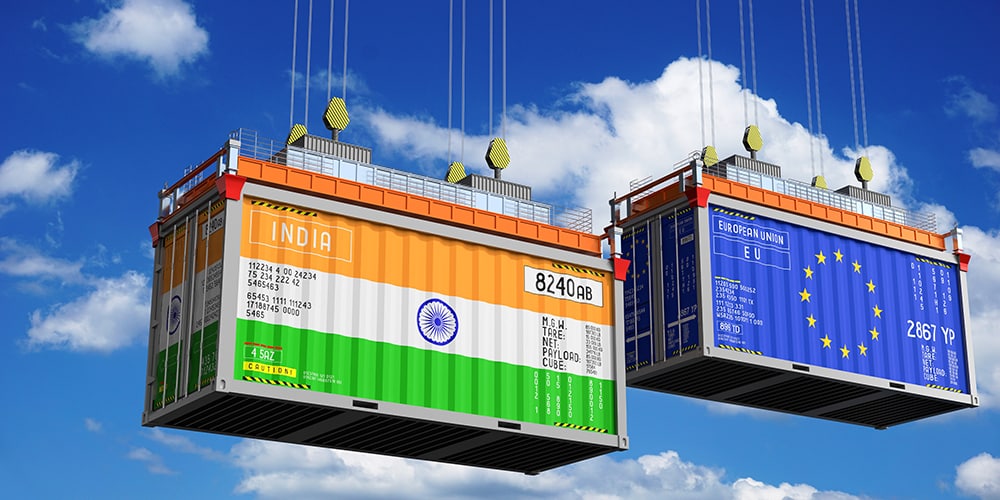Steel industry experts continue to watch India closely. In the latest steel news from the subcontinent, the country plans to introduce retaliatory tariffs on certain European Union steel imports. This comes after an unresolved trade conflict over the EU’s safeguard measures on steel products.

In a notification to the World Trade Organization, India announced plans to raise tariffs on select goods originating from the EU. This move is a response to what India claims to be trade losses amounting to US $4.412 billion between 2018 and 2023 – losses the country says are due to the EU’s restrictive measures.
Don’t miss out on valuable steel industry insights. Subscribe to MetalMiner’s free Monthly Metals index report and gain a competitive edge with comprehensive market analysis for 10 different metal sectors.
India’s Steel Industry Shifting from Defense to Offense
According to some media reports, India’s bilateral talks with the EU made little headway. While it remains unclear just what measures India will impose, the country will most certainly hike the duty on certain products originating in the EU.
Earlier in the year, several countries, including India, Switzerland, Russia and Japan, criticized the EU and the UK for imposing safeguard measures on steel imports, stating that these measures violated global trade rules. The WTO’s Safeguards Committee meeting saw these countries arguing against the EU and UK’s measures, with India also proposing additional customs duties in retaliation for the UK’s restrictions on steel products.

The WTO’s Safeguards Agreement allows temporary import restrictions through higher tariffs or other measures if a domestic industry suffers serious injury due to an unforeseen import surge. This was precisely what steel industry leaders across India claimed.
In fact, India reportedly told the WTO that the EU’s safeguard measures had led to a collective loss of US $ 4.412 billion between 2018 and 2023, with duty collections totaling US $1.103 billion. The country also told the organization that its planned suspension of concessions would lead to the imposition of equivalent duties on EU products.
Impact on India’s Steel Exports
Iron and steel exports to the EU from India increased from US $6.1 billion in 2022-23 to US $6.64 billion in 2023-24. Despite this growth, India remains concerned over the EU’s safeguard measures, which it argues violate global trade rules and the WTO’s Agreement on Safeguards.

Steel industry leaders and trade officials from India raised these concerns. In a similar move in 2022, India proposed a 15% customs duty on UK imports in retaliation for Britain’s steel restrictions. The year before, India proposed measures against the EU through the WTO in response to the bloc’s decision to impose safeguard duties on specific steel products.
Get all the latest steel news as well as information on other valuable commodities. Sign up for the free weekly MetalMiner newsletter here.
A Closer Look at India’s Imports
Safeguard measures generally apply to all imports, not just those from specific countries, with exceptions for developing nations contributing less than 3% of exports. These measures should not exceed four years. Since safeguards address “fair” trade, affected exporting countries can seek compensation through consultations or, if the parties fail to reach an agreement, impose retaliatory tariffs.

Amid global trade uncertainties, India’s exports are forging a new path through bilateral agreements, free trade agreements, and the exploration of untapped markets like Africa. In recent years, India has experienced a notable rise in exports of precious metals, minerals, automobiles, electronics, pharmaceuticals, organic chemicals, textiles, spices and defense equipment. This growth largely stems from initiatives like the Production-Linked Incentives scheme and the “Make in India” campaign.
The EU Remains an Integral Trade Partner
India’s exports to Europe reached a five-year high in FY24, with outbound shipments rising 65% year-on-year to 3.3 million tons, nearly doubling from FY20. However, setbacks in other markets dampened this success. According to the Indian Steel Ministry reports quoted by Hindu Businessline, exports to the UAE have hit a five-year low, and India has lost ground in Southeast Asia. Intense competition from Chinese exports has also significantly affected the prospects of Indian mills in both the UAE and Vietnam.
Get ahead of steel industry fluctuations. Explore MetalMiner’s full metal catalog and start getting metal price forecasts customized to your specific metal types and forms.




